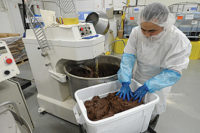
By Marina Mayer
Joe Perrino has seen it all. Whether it’s the now-defunct no-carb craze or the current self-rising crust fad, Home Run Inn, Inc. has endured the highs and the lows of the industry by simply doing what it does best - producing all-natural, wholesome frozen pizzas.
Now the Woodridge, Ill.-based frozen pizza producer is going all the way by increasing capacity, expanding lines and playing by the traditional family rules.
“We must be profitable, but we’re not focused on profitability as our main objective,” Perrino says. “It’s to make good-quality pizzas over and over and over again. Sell more [pizzas] tomorrow than we did the day before. We run our business more on entrepreneurial spirit than a corporate [model], where you have to hit these numbers. We ride the waves of what’s going to happen.”
The family-owned business operates out of the original 9,000-sq.-ft. plant in Chicago as well as its newly expanded 60,000-sq.-ft. headquarters location. At the time ofSnack Food & Wholesale Bakerymagazine’s visit, the Woodridge location was producing 10-in. sausage pizzas.
What makes Home Run Inn pizzas unique is that they aim to mimic the restaurants, says Mark Carlson, vice president of frozen food operations.
Typically, the Woodridge plant uses 20,000 to 30,000 lb. of flour per day that’s stored in an 80,000-lb. silo on the outside of the building. Flour is pneumatically conveyed into 400- to 500-lb. bowls, then mixed with vegetable oil from a 30,000-lb. vegetable oil tanker. Next, the operator adds yeast and salt and the dough is mixed for about nine minutes before it enters the dough chunker, which cuts the dough into 40-lb. blocks.
The dough is then divided and rounded into dough balls before they’re manually checkweighed and racked again. Then the dough balls are formed into different size crust shells via a hot-press that runs on a 10-second press cycle. During this process, the dough balls enter a die where it’s hit with 600 to 800 lb. of pressure that flattens the dough and fills up the inside of the ring. After hot pressing, the system releases with shots of air glossing over the dough. The pizza pie shells are then parbaked at 490°F for 90 seconds.
Line 1 is the larger system that usually runs 12-in. pizzas four days a week, 6-in. pizzas one day a week and then 10-in. ones are intermixed about every 10 days. The fully automated line consists of a moving fork-like hand that retracts and lays out each pizza crust one-by-one on the belt. It is PLC-controlled to ensure that pizzas aren’t dumped out on top of each other.
Home Run Inn receives fresh pork in 2,000-lb. bags every day, in which operators grind it, mix it and add proprietary spices. Half of the bags will be shipped out to the restaurants while the remainder are put into 600-lb. batches that are used for in-house production.
“We’ll go through one of these 600-lb. containers in about a half hour, or 10,000 to 11,000 lb. of sausage a day,” Carlson says. “We also do this so that our restaurants get fresh sausage daily.”
On the main topping line, a sensor indicates when a depositor applies sauce from an automated tank. When the sensor is tripped, sauce is deposited onto the pizza crust. The Woodridge facility goes through about 12,000 to 15,000 lb. of sauce a day.
The pizza crusts then enter an automatic dispensing system for applying sausage. On Line 1, the system rotates with the pizza. Raw sausage is pumped from the sausage machine and a knife moves back to ensure the proper amount extrudes through a 30-hole plate. Sensors, again, monitor the amount of topping that goes on each pizza. Afterward, lead production operators manually apply additional pieces of sausage to each one to ensure proper quality standards.
Meanwhile, blocks of cheese are cubed, diced and then either shipped out to the restaurants or saved for use on the line. Home Run Inn goes through about 120,000 lb. of cheese a week. Once the sausage is applied, the pizzas travel through the cheese waterfall where a giant rake pushes cheese on the pizza as the excess is caught on to the return belt that travels up and re-deposits the cheese into the system.
The pizzas are then parbaked at 495°F for another three minutes either in Line 1’s 80-ft. oven or in Line 2’s 40-ft. oven.
Then, they travel underneath the pepperoni applicator. Tubes of pepperoni are placed inside the bucket and a knife blade slices about 14 slices of pepperoni that drop right on to the pizzas. They then travel along a 20-ft. conveyor into the additional topping area where a secondary waterfall of bacon, vegetables and other secondary ingredients are dropped right on top of the pizzas.
The pizzas then reach the main freezer where they freeze at 10°F for 40 minutes.
Upon leaving the freezer, the pizzas travel on a 17-ft. decline into the packaging area, where they are conveyed into the shrink-fill film applicator and tunnel and individually wrapped in plastic. After all products receive SKUs [stock-keeping units], the products on Line 1 enter an automatic box former where a pusher pin comes down and pushes the pizza into the box. Then the boxes are sealed with two shots of glue on either side to seal the box tight before they are code-dated and embossed.
There are two quality control operators per shift in addition to a team of lead production employees who review every line employee every year.
Furthermore, Home Run Inn conducts a mock recall once a month to ensure product safety. Plus, both facilities receive audits every year by third party as well as the U.S. Department of Agriculture.
“We have to be able to show them that we can track down every single pizza with a 99% effective rate within two hours,” Carlson says. “We track everything, every load of cheese, every sausage bin, everything is tracked by quality control. If there are any problems or tampering, we’re able to track it right down to the time and source.”
In addition, all products run through a metal detector. If there’s even a tiny metal shaving, the controls will trigger the metal detector and the belt will retract and drop the pizzas into a bin. Any healthy misfit pizzas, or ones that are deemed not sellable in stores, are donated to the Greater Chicago Food Depository and Northern Illinois Food Bank.
“Back in the 1980s, we did everything by hand,” Carlson recalls. “The technology from year-to-year is just amazing.”
With a clear-cut plan, state-of-the-art machinery and the urge to resist fad temptations, Home Run Inn continues to go all the way for its consumers.




